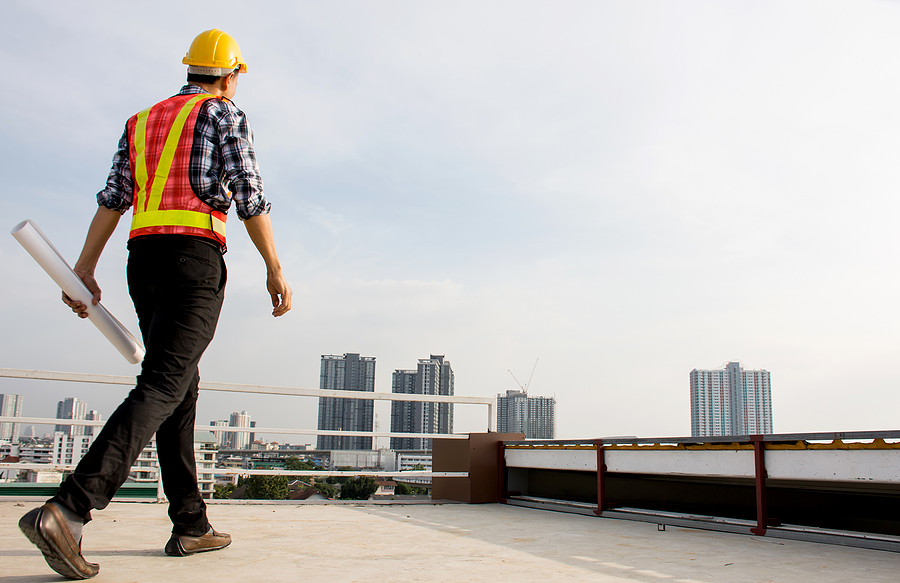How to Walk a Roof Safely

The idea of needing to walk a roof “safely” probably doesn’t seem odd or out of place to anyone. Walking a roof seems straightforward, just stay away from the edge and be careful.
Well, there are a whole slew of issues which could cause injuries that need to be taken into consideration when just simply walking a roof.
In this article we’ll be discussing why people would need to walk a roof, different rooftop hazards and solutions to those obstacles.
Reasons to Walk a Roof
Many commercial and industrial roofs have air handling equipment, piping, chillers, exhaust vents, and more. This type of equipment may need preventative or emergency maintenance which requires at least one individual to walk the roof to these units.
There may already be permanent fall protection installed on the rooftop such as guardrails, anchor points, or lifelines. All of which require periodic inspection and maintenance.
Additionally, roofs can serve the purpose of being an emergency escape route. A higher section of the building, a penthouse, or an elevator could empty out on to the roof in the event of a fire or other emergency. In that type of situation, it is even more critical that people can traverse the roof quickly and safely.
Rooftop Hazards

We’re going to make a bold statement: people can fall off roofs. Crazy, right? Sloped or flat, unprotected edges have the potential for several hazards; somebody could lose their footing, trip over something, be pushed accidentally, or be thrown off-balance by the wind. The tricky part is that the edge is not the only place with which you need to be concerned.
Firstly, there are skylights. Skylights are considered holes in the roof and can easily be fallen through if not protected properly. They are a major fall hazard that often gets overlooked because they’re “covered,” however the plastic or glass covers are often designed for debris, not for the weight of a human.
Staying in the realm of roof openings, access hatches and smoke vents are a concern as well. Like skylights, hatches and vents can be a secondary thought when it comes to rooftop safety.
Other falls can occur where the elevation of your roof changes. Buildings can be designed with different levels, a mechanical room, or any other number of structures that workers can find themselves on. Smaller roofs may not seem as big an issue because their falls are just to a lower level of the rooftop.
In general industry OSHA requires that you provide fall protection to anybody exposed to a potential fall of 4’ or greater. Just because your requirement says 4’ though, doesn’t mean that you can’t perform a hazard analysis and determine that even a shorter fall could cause injury or death.
Slips and Trips on Rooftops
Slips and trips can cause injury by themselves or can lead to a fall to a lower level. Many different obstacles, both man-made and natural can cause slips and trips on a rooftop. When performing a hazard analysis of your rooftop look at areas in which your people will be walking to perform the work they need to do.
Conduit/pipe runs, random wires, and other low obstacles could lead to somebody tripping and falling into equipment or to a lower level. There are low obstacles like firewalls or slight elevation changes that could also cause someone to slip.
Debris left on the roof by previous work crews can be enough to cause somebody to lose their footing or twist an ankle.
Moisture from rain, snow, or morning dew could also cause somebody to slip. Ice can also build up on a rooftop if unchecked which is more dangerous because ice is difficult to see at points and can lead more severe slips and falls.
Fall Protection Solutions

So, what can be done about all these potential hazards?
If you’ve got high traffic areas that could become slippery, roof pads are a simple and quick way to provide grip. On more dangerous surfaces, like metal roofs, or where conduit and other obstacles have you constantly changing direction or stepping over things. There are walkway systems that make it much easier and safer to traverse rooftops.
If some obstacles are too large to step over, run the entire width of the roof, or cause workers to go far out of their way. Crossover platforms are the perfect solution to, as the name implies, cross over obstacles on your rooftop.
When it comes to skylights, there are skylight screens or skylight guardrail that can be installed to prevent anyone from falling on or through the skylight.
Smoke vents can use skylight screens as well, but they aren’t the best solution. Using non-penetrating guardrail or mounted hatch railings to provide the best fall protection. Guardrail and hatch railing are also the most optimal solutions for other hatches around your rooftop.
Adding accessible and protected stairs and ladders for level changes will make it easier for workers and will prevent them “hopping down” to lower levels.
And lastly, make sure that the roof is part of a periodic maintenance program where it is cleared of debris, snow, or ice on a regular basis.
In Review
The idea that roofs are just wide-open flat surfaces is often not the case. Rooftop hazards exist that can make walking across a roof unsafe, but there are solutions available.
It is imperative that you, as a building owner or manager, determine what hazards your workers, contractors, or emergency responders may face.
If you need assistance with finding out the best solutions to protect and safely walk your rooftop, contact our experts today!
